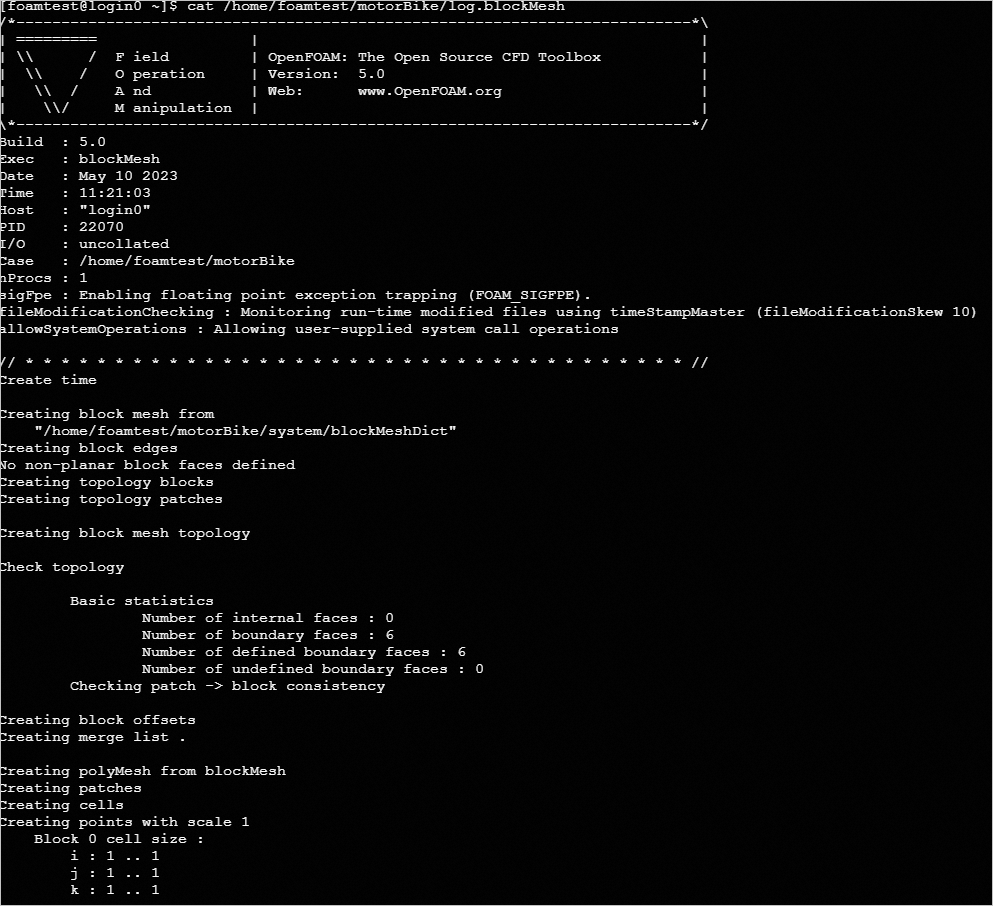This topic describes how to run Open Source Field Operation and Manipulation (OpenFOAM) in an Elastic High Performance Computing (E-HPC) cluster to perform a hydrodynamics simulation.
Background information
Open Source Field Operation and Manipulation (OpenFOAM) is a C++ toolbox designed to develop customized numerical solvers. OpenFOAM provides pre-processing and post-processing utilities that resolve continuum mechanics-related problems, including computational fluid dynamics (CFD). For more information, visit the OpenFOAM official website.
In this example, an OpenFOAM solver named simpleFoam is used to calculate the outflow field of a motorcycle. Sample directory: $FOAM_TUTORIALS/incompressible/simpleFoam/motorBike/.
Preparations
Create an E-HPC cluster. For more information, see Create a cluster by using the wizard.
Configure the following parameters.
Parameter
Description
Hardware settings
Deploy a standard cluster that consists of two management nodes, one compute node, and one logon node. All nodes use ecs.c7.large Elastic Compute Service (ECS) instances. Each instance has 2 vCPUs, 4 GiB of memory, and one 2.7 GHz third-generation Intel Xeon Scalable (Ice Lake) processor.
Software settings
Deploy a CentOS 7.6 public image and the PBS scheduler.
Create a cluster user. For more information, see Create a user.
The user is used to log on to the cluster, compile LAMMPS, and submit jobs. In this example, the following information is used to create the user:
Username: foamtest
User group: sudo permission group
Install OpenFOAM. For more information, see Install software.
Install the following software:
openfoam-openmpi V5.0
openmpi V1.10.7
Step 1: Connect to the cluster
Connect to the cluster by using one of the following methods: In this example, the username used is "foamtest". After you connect to the cluster, you are logged on to /home/foamtest by default.
Use an E-HPC client to log on to a cluster
The scheduler of the cluster must be PBS. Make sure that you have downloaded and installed an E-HPC client and deployed the environment required for the client. For more information, see Deploy an environment for an E-HPC client.
Start and log on to your E-HPC client.
In the left-side navigation pane, click Session Management.
In the upper-right corner of the Session Management page, click terminal to open the Terminal window.
Use the E-HPC console to log on to a cluster
Log on to the E-HPC console.
In the upper-left corner of the top navigation bar, select a region.
In the left-side navigation pane, click Cluster.
On the Cluster page, find the cluster and click Connect.
In the Connect panel, enter a username and a password, and click Connect via SSH.
Step 2: Run the sample file
Configure the environment variables.
export MODULEPATH=/opt/ehpcmodulefiles/ module load openfoam-openmpi/5.0 module load openmpi/1.10.7Configure the sample file.
mkdir /home/foamtest/motorBike cp -r /opt/OpenFOAM/OpenFOAM-5.0/tutorials/incompressible/simpleFoam/motorBike/* /home/foamtest/motorBikeNoteIn this example, the OpenFOAM solver named simpleFoam is used to calculate the outflow field of a motorcycle. Sample directory:
$FOAM_TUTORIALS/incompressible/simpleFoam/motorBike/.Run the sample file.
cd /home/foamtest/motorBike source /opt/OpenFOAM/OpenFOAM-5.0/etc/bashrc ./Allrun
Step 3: View the results
Run the following command to view the output file of the job:
cat /home/foamtest/motorBike/log.blockMeshThe following code provides an example of the returned output.
